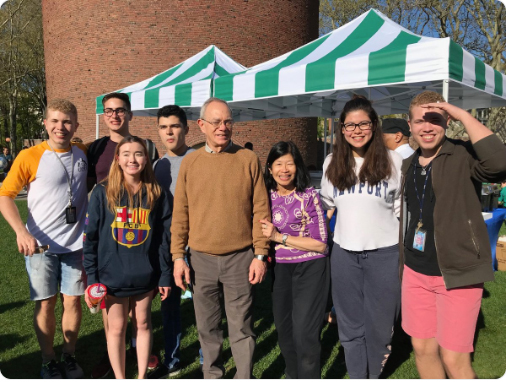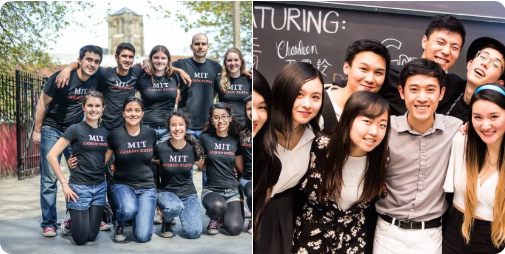The festival stage show: presented and performed by MIT students!
Asian Dance Team
Seventeen Medley and Harmony
In recent years, K-pop (Korean pop) artists have found value in performing eye-catching dance sequences to their songs. It has become common for fans to learn and make their own adaptations of these dances, either for local performances or cover videos. The Asian Dance Team will present their adaptation of a medley of songs by the K-pop group SEVENTEEN.
Classical Chinese dance is often used to honor symbols of importance in Chinese culture. In Harmony, the dance depicts the strength of harmony between Yin and Yang. Music is created by heaven and is masculine and positive (Yang); ritual is created by Earth and is feminine and negative (Yin). If there is harmony between Yin and Yang, the universe will gain; if there is harmony between ritual and music, all will be at peace.
Mandingueiros dos Palmares Capoeira
Capoeira
Rooted in Afro-Brazilian culture, Capoeira is a martial art that combines elements of dance, acrobatics, and music. It was created in Brazil by slaves, mainly from Angola, some time after the 16th century. Developed as a method of self- defense disguised as a dance, Capoeira was born of the Brazilian slaves’ intense desire for freedom. Capoeira nowadays is not only a martial art, but an active exporter of Brazilian culture all over the world. It is a dynamic dialogue between athlete-artists—a conversation through movement which can take on many shades of meaning. Mestre Chuvisco teaches capoeira classes in Cambridge and has given more than four decades of his life to the art, both through practice and teaching. Mestre Chuvisco’s group “Mandingueiros dos Palmares” currently has branches in Brazil, Mexico, and in the US.
MIT Syncopasian Small Group
with performers Dou Dou, Crystal Chang, Madeline Zhang, Emily Hu, Tianyi Zeng, Tiancheng Qin, and Daniel Whatley
Yi Ran Yi Bao Zha, (roughly) Flammable and Explosive
This Chinese song was written by independent Chinese musician Chen Li and made popular by Chinese pop singer Hua Chenyu. It will be performed in a capella style by seven members of MIT Syncopasian, with an original arrangement by Crystal Chang and Dou Dou. Musically, it is an unusual mix of Asian contemporary opera and Chinese pop, giving it much room for the performers to add their own styles and musicality. There is also a brief interlude in the style of a Baroque fugue, which has European classical roots. The song conveys the many confusing and conflicting emotions (and occasional demands) of being in a relationship, to an extent at which it becomes easily “flammable and explosive,” as the song title suggests. The Chinese lyrics are sophisticated and poetic—akin to Shakespearean English—with few repeating lines, showing the immense capacity of Chinese language to capture complexity concisely. The rap part of the music, written and added by Crystal and Dou, contains extracts from an extremely well-known poem by the ancient poet Li Bai, as well as another contemporary Chinese pop song.
Palestine @ MIT
A Night From Palestine
Dabke, a dance of Arabic culture, was passed down throughout history in The Levant region, legend says that people in that region made the roofs of their houses with tree branches and mud. Anytime the weather changed, the mud would crack and members of their family or community would come to help patch it by forming a line, joining hands, and stomping the mud into place. Today, dabke is performed or danced at weddings, special occasions, and family gatherings in Palestine, Lebanon, Syria, and Jordan.
MIT Lion Dance Team
MIT Lion Dance Team incorporates traditional stunts with modern skits and welcomes newcomers to the art! They perform throughout the greater Boston area to bring Chinese culture to various venues. The traditional Chinese lion dance is usually performed during Chinese New Year or other cultural events, with two people operating the head and tail. The MIT lions are made of aluminum, plastic, and cloth—and weigh about 15 pounds each!
MIT Belly Dancing Club
MIT Belly Dancing Club presents the Egyptian dance traditions through a mix of Folklore dance & belly dance. The Egyptian folklore was revived by the famous “Mahmoud Reda” who founded “Reda Troupe” in 1959. Reda troupe presented many dances that taught us a lot about the different cultures across Egypt. Some of these dances mimic the coastal lifestyle in Alexandria; others show the Nubian culture in the Southern of Egypt (Luxor and Aswan), the bedouin cultures in the Egyptian deserts, and the fishermen’s culture around the Suez Canal. MIT Belly dancing combines these folklore moves with traditional belly dancing moves to produce fun and culturally educational performances!
A Tribute to Rabbie Burns, by Craig Thorburn
The Address to the Haggis (1786)
Craig, a native of Scotland, declaims a poem written by Rabbie (Robert) Burns of Ayrshire. The Address to the Haggis is recited at a “Burns Supper” in Scotland, given annually to celebrate the life and works of Burns. Haggis is a traditional dish of Scotland consisting of lamb, although it is also sometimes referred to as a mythical creature that roams the highlands. A Burns Supper has been held at MIT for the last several years—will you address the haggis next time?
MIT Tango Club
Argentine Tango
Performed by Giulia Agostinelli, Zied Ben Chaouch, Mikhail Bessmeltsev, Azriel Ghadooshahy, Yulia Rybakova, and Sveta Zhuk
Argentine Tango is a partnered social dance which emphasizes connection between partners and moving together with the music. The MIT Tango club is dedicated to promoting Argentine Tango to the MIT community and around the Greater Boston area. They offer regular classes, special workshops, and free weekly practice sessions, and they are always excited to welcome new people to the dance! For more information please see https://sites.google.com/site/mittangoclub/home/.
A Ribbon Dance, by Kedi Hu
Goddess of the Skies
天 女散花 (roughly translated to Celestial Goddess Scattering Flowers) is a Chinese ribbon dance. The name originates from a legend about flower goddesses scattering petals in the heavens, some of which fell to earth like snow, decorating the mountains and grassland with flora. Originally used in Peking Opera, the ribbons are swept with the dancer across the stage, representing the vivid colors and life brought to Earth by the scattered flowers. Original Choreography by Ms. Bing Yang.
MIT Casino Rueda
Bailamos Por MIT
Casino Rueda, or Rueda de Casino, originated in Cuba. The name “Casino” refers to dancing in turns and steps, and the term “Rueda” (meaning wheel in Spanish) refers to dancing in a circular configuration in which couples exchange partners and move in synchronization to salsa music. Each move has a name and is led by a “caller” who calls the moves. As few as two, to an unlimited number of couples in circles within circles, can dance the Rueda!
MIT Casino Rueda has been teaching and performing Rueda since 1999 at MIT. Given the “communal” nature of this dance genre, they would welcome more dancers from the MIT community to join in this lively and fun dance genre.
MIT Chamber Music Society Jazz Combo
Bounce, Nate Smith (b. 1974)
- Keala Kaumeheiwa, coach, bass
- Sahin Naqvi, tenor saxophone
- Alex Mijailovic, guitar
- Jonathan Gilad, drums
MIT Ethiopian Eritrean Student Association
Traditional Dances
Ethiopia and Eritrea are widely diverse countries with more than 80 unique ethnic, cultural, custom, and linguistic groups, all of which aspects shape countries’ traditional dances. Association members will demonstrate popular dances—including eskista, or “dancing shoulders”—from a number of different regions.
The Spicy Girls: Murphy Yuezhen Niu and Helena Zhang
War and Beauty of Ancient China
The performance begins with the classic poem 幽兰操 (you lan cao), composed by the renowned poet Han Yu more than 1300 years ago during the Tang Dynasty and set to a Chinese folk melody. In the song, a gentleman has a special encounter with a beautiful orchid, which he cares for and cherishes throughout his life and travels. Murphy and Helena studied the work of Han Yu in elementary school and have been appreciating the beauty of the Chinese language through this philosophical piece of poetry ever since.
The performance then transitions to one of the most famous pieces in classical Chinese music: 十面埋伏 (shi mian mai fu), or “Ambush from Ten Sides”. It depicts a pivotal battle in 202 BC between the Han and Chu armies that would lead to the founding of the Han Dynasty. Here, they arranged the piece into a Pipa-Guzheng duet, depicting the fearsome battle using a wide range of performance techniques: the beat of the drums, the ambush, and the Chu general finally driven to suicide in utter defeat. Murphy and Helena love this piece because in addition to its venerable age and commemoration of ancient Chinese culture, it has a rock and roll beat.
Sakata Afrique
Dances of the African/Caribbean Diaspora
Sakata Afrique, MIT’s only African dance group, was founded in January 2013. Created to help MIT students of African origin preserve their cultural heritage through music and dance and to introduce African dance to the MIT community, the troupe really wants to emphasize the reason why Africans love dancing in the first place: expression of individuality, and fun! Performers: Fejiro Oruerio; Gabrielle Ballard; Kwabena Ofori-Atta; Lisbeth Acevedo; Emmanuel Azuh; Lisa Madungwe; Tiera Guin; Amber Meighan; Ashton Dacon; and Sitara Persad
MIT Mirchi
Bollywood Fusion Dance
Mirchi is MIT’s competitive co-ed Bollywood-fusion dance team. Formed in 2012, Mirchi’s collective spirit embodies community, culture, and a love for all forms of dance, including Indian classical, Bhangra, Hip Hop, Bollywood, and Contemporary dance styles. Over the years, they’ve been honored to represent MIT and greater Boston at various competitions and showcases across the country. Word on the street, Mirchi doesn't miss a beat—they live to set the stage on fire.
Kilikia, by Siranush Babakhanova
Kilikia is a solo dance, representing Armenian culture and Republic of Armenia, as well as the whole Armenian diaspora abroad. In this performance, the traditional garments, classic Armenian moves, and music are coupled with modern motifs. It tells the story of the great Armenian Kingdom of Cilicia (in south coastal region of Asia Minor), which fell to invasions in the 14th century. The singers yearn for their homeland—they cry for a chance to return there, to see the stones, the castles and churches, the sunlight and to hear the song of birds, the wind—and they dream of Kilikia, which could not be replaced in their hearts with nothing else. This song and the dance is dedicated to the descendants of Armenian Genocide 1915, who are far away from their homeland, as well as all the refugees of past years’ events.
MIT Ohms
A Capella by the Ohms
South Asia has always been proud of and well known for its musical diversity and technique. A lot of classical Indian vocal music involves demonstrations of vocal skill and control. This type of singing often follows a variety of structures involving significant tonal and rhythmic differences from traditional Western music. In current times, “mainstream” South Asian music comes from Bollywood (Indian movie scene) films, as most movies in India are portrayed as musicals. Songs from these movies often take inspiration from Western styles, though some also follow more classical roots. The Ohms utilize sound from all kinds of music of South Asia, occasionally mixing Western pop with Bollywood pop, grafting them to classical roots, and growing their own modern music.
With special appearances by
Gamalan Galak Tika
Traditional and new Balinese music and dance
Gamalan Galak Tika’s festival performance will feature new music by Dewa Ketut Alit (visiting artist and guest artistic director). The group was founded in 1993 (and still led) by Professor Evan Ziporyn. Galak Tika is dedicated to commissioning and performing new works by Balinese and American composers, for gamelan and mixed ensembles of gamelan and Western instruments, as well as performing traditional Balinese music and dance.
The word gamelan means “to hammer”; the term refers generally to the large percussion orchestras of Java and Bali. The primary instruments are gongs, metallophones, and hand drums, with cymbals, vocals, bamboo flutes, and spiked fiddles used, as well. Gamelan is the wellspring of all music in Bali, both sacred and secular. The Balinese people are ardent practitioners of a unique form of Hinduism and gamelan is necessary for all ritual events, as well as to mark any large social occasion. There are dozens of different types of gamelans in Bali, ranging from large metal orchestras to bamboo ensembles, vocal groups, and groups dedicated to the imitation of frog sounds. All the music is marked by the use of one of two non-tempered pentatonic scales—pelog or slendro—and by rhythmically precise interlocking parts known as kotekan.
and
Rambax MIT
Sabar drumming and dance tradition of the Wolof people of Senegal, West Africa
Rambax MIT is co-directed by master Senegalese drummer Lamine Touré and Professor Patricia Tang. It is an ensemble dedicated to learning the sabar drumming and dance tradition of the Wolof people of Senegal, West Africa. Lamine Touré comes from a family of griots who have passed on the tradition of sabar drumming for many generations. The students of Rambax MIT are carrying on that tradition and are proud to share their love of sabar!


